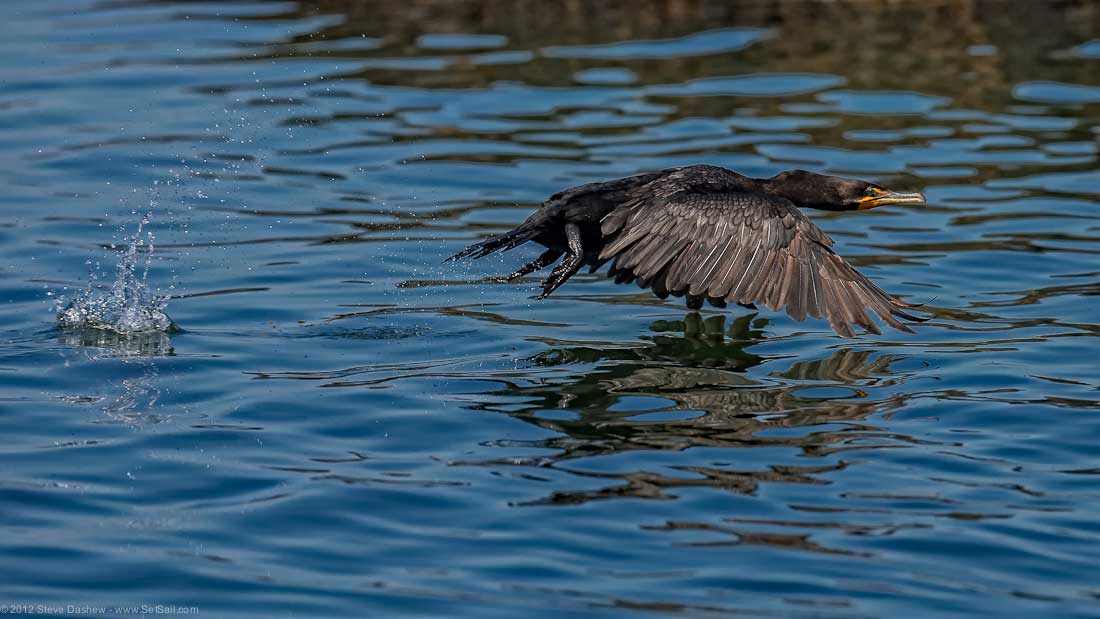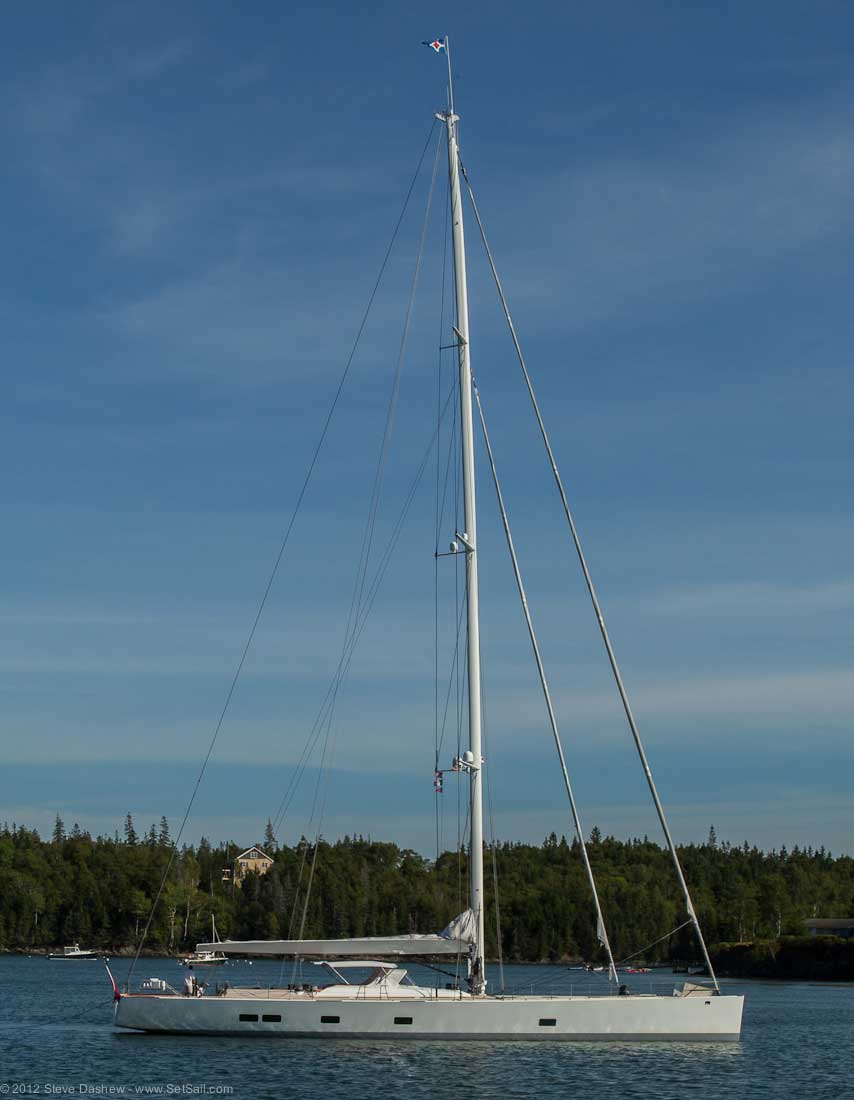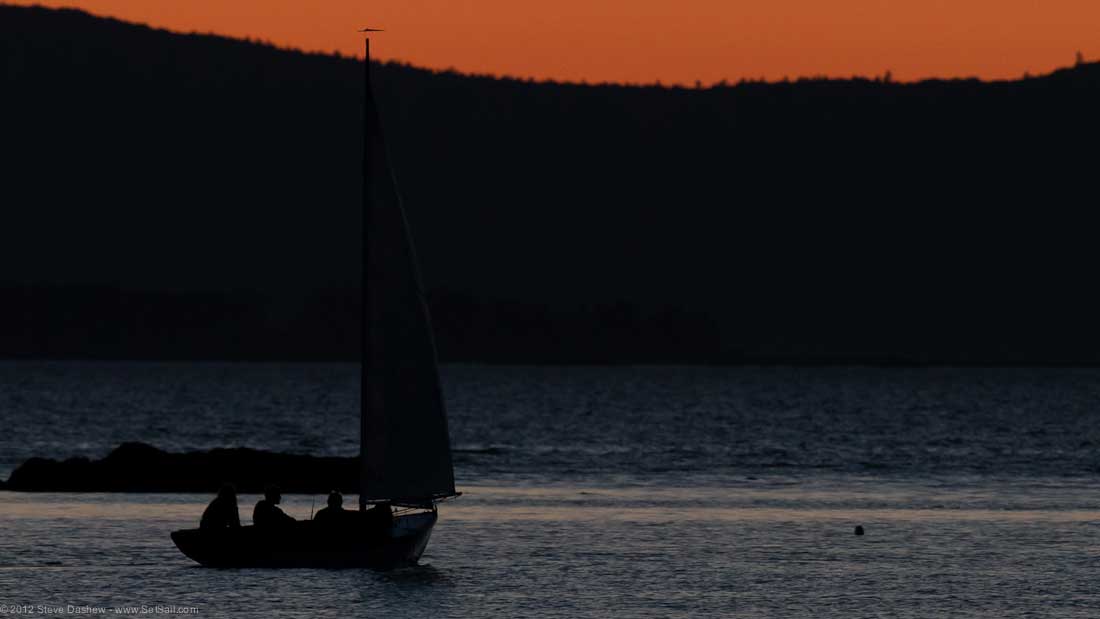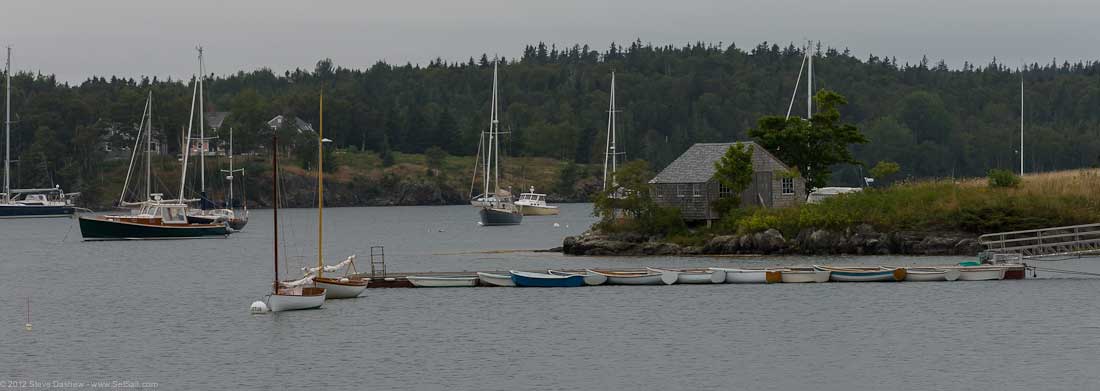
Pulpit Harbor, Maine is one of those destinations that can catch you in its web. There is room to anchor, it is well-protected from all but one direction, wild life a-plenty is in residence, interesting boats to study come and go, and there are friends new and old with whom to discourse. Add good communications to the outside world, and big city life in Camden and Rockland an hour away by boat, and you have an optimum cruising destination.

Shoreside development is limited, there are a few docks, one of which is public, and a nice walk inland, which we have yet to test since we have not seen cause to step ashore.

The variety of yachts has brought back many memories. Take this lovely yawl. Our first lead mine, Intermezzo, was a similar CCA design, with graceful overhangs, and exactly the same color, both of which characteristics were highly inefficient.

Although it has been less than clear, for the most part, even the fog has been warm. If this is global warming, we like it.

There is an osprey nest guarding the harbor entrance, with several chicks.

The parents periodically sit with the youngsters, flapping their wings in what appears to be encouragement to fly, but so far no takers.

Here is a yacht which indirectly had a major impact on our efforts in the yachting business: Phillipe Jeantot’s Dumas design from the very first single-handed BOC around the world race. She had (then) unfashionably short ends. Prior to Jeantot’s win, our short-ended designs were too radical looking. Post Jeantot, we became more acceptable.

When the overcast clears, and the sky changes color, it is very much appreciated.

And blue makes us positively giddy.

Although there remains some form of air pollution–witness the moon’s orange color–it is occasionally clear in the evening.

We have been testing a new camera body, the Canon 1DX. This is Canon’s finest offering to date and it is a truly remarkable piece of hardware. The photo above is what we call a snap shot, an unplanned quick pull on the trigger as a new event unfolds. Normally we might get one out of fifty or a hundred images like this from a snap. We have dozens of this variety from our first outing in the dinghy.

Pulpit is still a working harbor, and there are half a dozen lobster-men plying a very difficult trade, this year’s prices being extremely depressed.

The contrast of the weekend cottages ashore, of which this is a modest example, large yachts, and lobster-men, all in peaceful coexistence, is a more pleasant aspect of society than is currently on display in the US election cycle rhetoric.

We started out talking about overhangs. Look where aesthetics have evolved!

There is little wasted overhang in this yacht, and we think it safe to assume she’ll be okay in light-going, speed wise. However, the very clean bow, sans anchoring gear (it being underwater), may be taking appearances too far. We prefer our anchor where we can see it and are 100% certain it will come up and stow, or deploy.

Of course you do need the correct geometry for the anchor to stow properly and self launch.

The ospreys put on a clinic in fishing and efficient cargo carrying skills. Note the prey, aligned with the direction of flight for minimum drag.

This is a sailor’s harbor, stinkpots being barely tolerated. In the late evening and early morning there will be folks out enjoying a quiet interlude.

Yawls are in favor. Although this is a very inefficient use of weight and windage aloft, it does look handsome, and the mizzen is useful as a riding sail (but little else).

Now this takes us back a few years.

And since we’re being nostalgic, we’ll admit to a soft spot for schooners, of the traditional variety. Having gone to sea at a tender age aboard a 76′ Alden schooner, gaff rigged of course (at least initially), this image can bring back the smells of hemp and tar, and the creak of the gaffs working in a seaway.

The anchor dance, as we used to refer to it, looks and sounds romantic. But truth be told, having been on the cranking end of that big winch, we prefer self-stowing anchors that come home with the push of a button.

We’ve been here as well, albeit as the result of a balky drive line or engine, rather than through lack thereof. Surprising too how little power is required to move a large sailing yacht. The 50 foot Intermezzo would cruise nicely at three to four knots with a four HP outboard on the dink tied alongside. Of course it took a while to stop.

If the schooner rig with two spars is good, how about a third?

There seem to be a lot of black yachts these days. Nice looking here, but perhaps a touch impractical in warmer climates. Note the awning, in Maine no less. Isn’t global warming wonderful?

So far optimal light for photography has been lacking. Not more than ten minutes this week in total. The silver lining in this is that it makes it easier to keep our noses to the grindstones, which otherwise might be difficult.

We mentioned the Canon 1Dx we’re learning about. Where the other photos were shot in less than perfect light, this and the following were in positively horrible, harsh, zero contrast conditions.

We would not normally even bother shooting, but being in test mode were trying different combinations of exposure compensation and ISO (film speed). We are frankly amazed and delighted by the potential these exhibit. Now we need to find some lovely light and experience what we expect to be a new quality standard.

Post script: It is Saturday, early evening, and we’ve forced ourselves to take a walk ashore.

The few drivers wave as they past obvious interlopers, the occasional householder smiles and engages in a bit of polite discourse, and we learn from a fisherman of a festival in a nearby town, complete with five hours of live music.

There’s a bit of color in the otherwise dull light.

And here and there a lovely flower to entice the foot weary traveler onward.

We may bestir ourselves to partake in the festival, or at least listen to a bit of music. If this lofty goal is attained, your faithful correspondents shall revert in due course.


August 12th, 2012 at 8:00 pm
Aah, you do give us presents Dashew. Thanks.
August 12th, 2012 at 8:46 pm
Fantastic photos Steve. I got an OK photo of an Osprey at the weekend (Victoria, Australia) and was rapt but your pics have blown me away. What size lens? How close? and what shutter speed please?
Thanks a lot,
Tom
August 12th, 2012 at 11:44 pm
Lens is a 400mm prime (Canon), 1/3200 shutter speed, ISO 800, around F8 aperture (varies), typically shooting with one stop of exposure compensation (dark bird, against light sky), and then processing in LightRoom 3. The most important adjustment in LR is “highlights” which is backed off all thew ay to drop some of the extra brightness out of the sky. Body is the Canon 1DX (full frame), which appears to have at least a full stop better range in HDR photos than anything we have used before. We are barely scratching the surface of what the 1DX can do. As to distance, between 30 and 60 meters as a guess.
August 13th, 2012 at 8:31 pm
Thank you for the tips Steve. I spent a few months cruising in Patagonia a couple of years ago. I reckon “Wind Horse” and your Cannon would be an awesome combination down there. Regards, Tom
August 13th, 2012 at 8:50 pm
Would love to test the gear down there for sure, in particular in winter.
August 13th, 2012 at 2:18 am
I am sooo glad you embraced photography!
cheers
Warren
August 13th, 2012 at 8:19 am
Have to admit we were forced into it after giving up soaring, bot now we’d rather shoot than do almost anything else.
September 1st, 2012 at 8:13 pm
As lifelong summer residents (low gray house in meadow of inner harbor, with bench overlooking outer harbor) of Pulpit Harbor we appreciate and agree with all your observations, it is our pleasure to look at, enjoy, and sail with all those who visit by water. The nice Netherlanders sailing the Dumas boat tipped us to your website and designs. We wish you many more great days on the water.
Gene and Parry